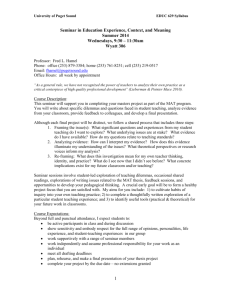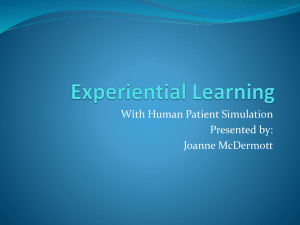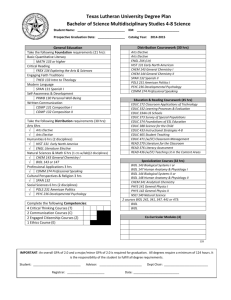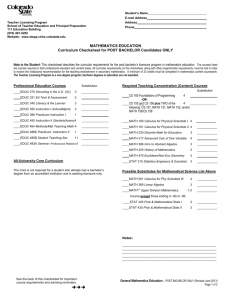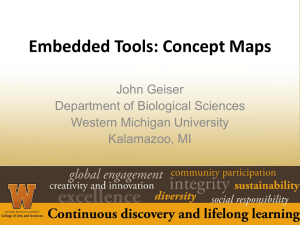Advanced Program Reading Competency Matrix
advertisement
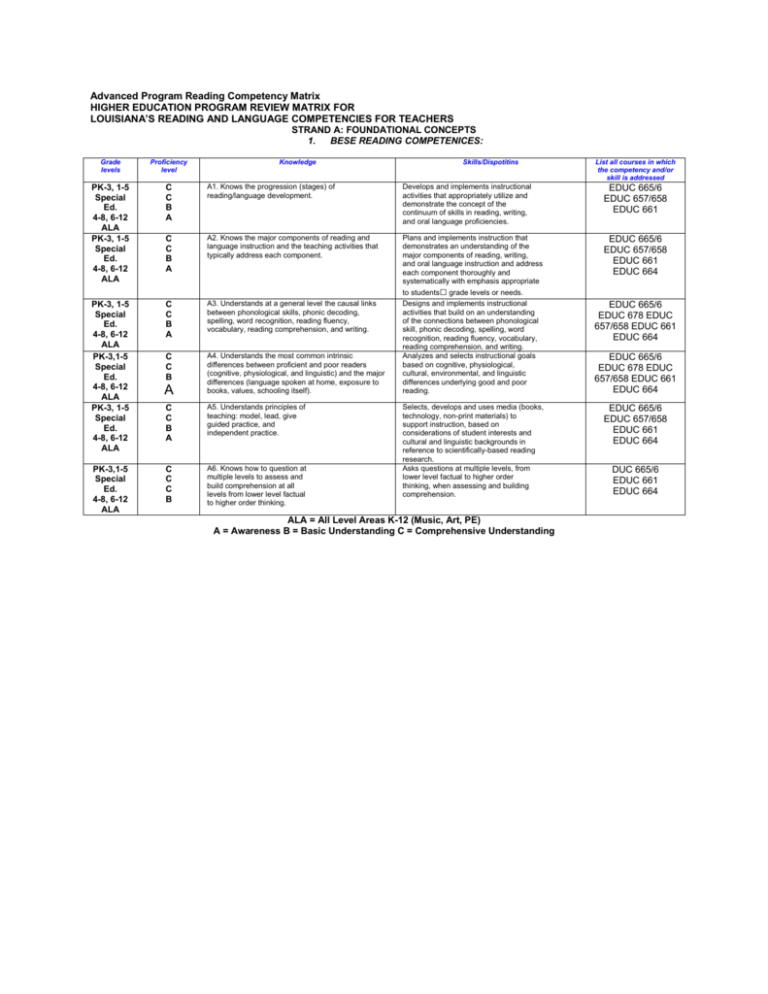
Advanced Program Reading Competency Matrix HIGHER EDUCATION PROGRAM REVIEW MATRIX FOR LOUISIANA’S READING AND LANGUAGE COMPETENCIES FOR TEACHERS STRAND A: FOUNDATIONAL CONCEPTS 1. BESE READING COMPETENICES: Grade levels Proficiency level PK-3, 1-5 Special Ed. 4-8, 6-12 ALA PK-3, 1-5 Special Ed. 4-8, 6-12 ALA C C B A A1. Knows the progression (stages) of reading/language development. Develops and implements instructional activities that appropriately utilize and demonstrate the concept of the continuum of skills in reading, writing, and oral language proficiencies. EDUC 665/6 EDUC 657/658 EDUC 661 C C B A A2. Knows the major components of reading and language instruction and the teaching activities that typically address each component. EDUC 665/6 EDUC 657/658 EDUC 661 EDUC 664 PK-3, 1-5 Special Ed. 4-8, 6-12 ALA PK-3,1-5 Special Ed. 4-8, 6-12 ALA PK-3, 1-5 Special Ed. 4-8, 6-12 ALA C C B A A3. Understands at a general level the causal links between phonological skills, phonic decoding, spelling, word recognition, reading fluency, vocabulary, reading comprehension, and writing. C C B A4. Understands the most common intrinsic differences between proficient and poor readers (cognitive, physiological, and linguistic) and the major differences (language spoken at home, exposure to books, values, schooling itself). Plans and implements instruction that demonstrates an understanding of the major components of reading, writing, and oral language instruction and address each component thoroughly and systematically with emphasis appropriate to students� grade levels or needs. Designs and implements instructional activities that build on an understanding of the connections between phonological skill, phonic decoding, spelling, word recognition, reading fluency, vocabulary, reading comprehension, and writing. Analyzes and selects instructional goals based on cognitive, physiological, cultural, environmental, and linguistic differences underlying good and poor reading. PK-3,1-5 Special Ed. 4-8, 6-12 ALA A Knowledge C C B A A5. Understands principles of teaching: model, lead, give guided practice, and independent practice. C C C B A6. Knows how to question at multiple levels to assess and build comprehension at all levels from lower level factual to higher order thinking. Skills/Dispotitins Selects, develops and uses media (books, technology, non-print materials) to support instruction, based on considerations of student interests and cultural and linguistic backgrounds in reference to scientifically-based reading research. Asks questions at multiple levels, from lower level factual to higher order thinking, when assessing and building comprehension. ALA = All Level Areas K-12 (Music, Art, PE) A = Awareness B = Basic Understanding C = Comprehensive Understanding List all courses in which the competency and/or skill is addressed EDUC 665/6 EDUC 678 EDUC 657/658 EDUC 661 EDUC 664 EDUC 665/6 EDUC 678 EDUC 657/658 EDUC 661 EDUC 664 EDUC 665/6 EDUC 657/658 EDUC 661 EDUC 664 DUC 665/6 EDUC 661 EDUC 664 STRAND C: PHONEMIC AWARENESS AND LETTER KNOWLEDGE 1. BESE READING COMPETENICES: Grade levels Proficiency level Knowledge PK - 3 Special Ed 1-5 C PK - 3 Special Ed 1-5 C PK - 3 Special Ed 1-5 C PK - 3 Special Ed 1-5 C PK - 3 Special Ed 1-5 C PK - 3 Special Ed 1–5 4-8 C C1. Knows the progression of development of phonological skill (e.g., rhyme, syllable, onset-rime, phoneme segmentation, blending, and substitution). C2. Understands the difference between speech sounds (phonemes) and the letters/letter combinations (graphemes) that represent them. C3. Knows how to identify and pronounce the speech sounds in standard English (consonant and vowel phoneme systems). C4. Understands the print concepts young children must develop (e.g., directionality, connection of print to meaning) C5. Knows how to segment and blend any single-syllable word at the onset-rime and phoneme level C6. Understands the role of letter name knowledge in reading and spelling. C B C B C C B C C C B Skills/Dispotitins List all courses in which the competency and/or skill is addressed Selects and instructs a range of activities representing a developmental progression of phonological skill (words in sentences; rhyming; oral word repetition; syllable counting; onset-rime segmentation and blending; phoneme identification, segmentation, and blending). EDUC 665/6 EDUC 657/658 Designs lessons that begin with auditory phonemic awareness activities, then links phonemes with letters as soon as students develop an adequate level of phonetic awareness. EDUC 678 EDUC 657/658 Demonstrates appropriate enunciation in oral demonstrations, especially when conducting phonemic awareness lessons. EDUC 665/6 EDUC 678 EDUC 657/658 Explains and demonstrates through shared reading and oral reading how print is used when reading a book. (e.g., provides details that readers take for granted while reading such as sentences, paragraphs, and that the end of lines on a page does not necessarily mean the end of a unit of meaning). Models and assists students in segmenting and blending single-syllable words at the onset-rime and phoneme level using words with two, three, and four phonemes. EDUC 665/6 EDUC 657/658 EDUC 661 Uses techniques for teaching fluency of letter naming, matching, and writing, including multisensory strategies for teaching letter identification and letter formation. EDUC 665/6 EDUC 657/658 ALA = All Level Areas K-12 (Music, Art, PE) A = Awareness B = Basic Understanding C = Comprehensive Understanding EDUC 665/6 EDUC 678 EDUC 657/658 EDUC 661 STRAND D: PHONICS AND WORD RECOGNITION 1. BESE READING COMPETENICES: Proficiency level Knowledge PK-3, 1-5 Special Ed 4-8, 612 C C A PK-3, 1-5 Special Ed 4-8 C C A D1. Understands the various structures of language that underline the English spelling system (e.g. phonemegrapheme, syllable pattern, morpheme units in print, and word origin). D2. Understands explicit, systematic teaching and implicit, incidental, and opportunistic teaching of phonics. PK-3, 1-5 Special Ed 4-8 C C A Grade levels Skills/Dispotitins D3. Understands the developmental progression in which orthographic knowledge is generally acquired. List all courses in which the competency and/or skill is addressed Identifies the kind of phonics and spelling instruction that is in an adopted comprehensive reading program (systematic, incidental, synthetic, analytic). Develops lessons that include practice in reading texts that are written for students to use their knowledge of language structure to decode and read words EDUC 665/6 EDUC 678 EDUC 657/658 Teaches all steps in a decoding lesson, resulting in reading words fluently, accurately, and with appropriate intonation and expression. Uses the following systematic progression to teach word reading so as to make public the important steps involved in reading a word: 1. Students orally produce each sound in a word and sustain that sound as they progress to the next. 2. Students must be taught to put those sounds together to make a whole word. 3. Students sound out the letter-sound correspondences "in their head" or silently and then produce the whole word. Selects and delivers grade-appropriate lessons on spelling, phonics, and word identification skills. EDUC 678 EDUC 657/658 EDUC 665/6 EDUC 661 ALA = All Level Areas K-12 (Music, Art, PE) A = Awareness B = Basic Understanding C = Comprehensive Understanding STRAND E: FLUENT, AUTOMATIC READING OF TEXT 1. BESE READING COMPETENCIES: Grade levels Proficiency level Knowledge Skills/Dispotitins List all courses in which the competency and/or skill is addressed PK-3, 15 Special Ed 4-8, 6-12 C C B A E1. Understands the role of fluency in word recognition, oral reading, silent reading, and comprehension of written discourse. Provides opportunities for multiple readings of continuous text with corrective feedback to promote speed, accuracy, comprehension, and expression. EDUC 665/6 EDUC 657/658 EDUC 661 PK-3, 15 Special Ed 4-8, 6-12 C C B Determines the reading level of text and the student�s reading level; and selects appropriate text to match the student�s instructional and independent reading levels. EDUC 665/6 EDUC 661 EDUC 664 PK-3, 15 Special Ed 4-8, 6-12 C C B A E2. Knows how to define and identify examples of text at a student�s frustration, instructional, and independent reading levels. E3. Understands reading fluency from multiple perspectives: stages of normal reading development, intrinsic characteristics of some reading disorders, and consequences of practice and instruction Implements instructional strategies targeting the unique needs of each student to foster reading fluency EDUC 665/6 EDUC 661 STRAND F VOCABULARY 1. BESE READING COMPETENCIES: Grade levels Proficiency level Knowledge Skills/Dispotitins List all courses in which the competency and/or skill is addressed PK-3, 1-5 4-8, 6 12 Special Ed ALA PK-3, 1-5 4-8, 6 12 Special Ed ALA PK-3, 1-5 4-8, 6 12 Special Ed ALA PK-3, 1-5 4-8, 6 12 Special Ed PK-3, 1-5 4-8, 6 12 Special Ed C C C A F1. Understands the role of vocabulary development and vocabulary knowledge in comprehension. Understands the concept of building word consciousness. Structures lessons and selects appropriate words to develop students� vocabulary using strategies and materials. EDUC 665/6 EDUC 657/658 EDUC 661 EDUC 664 EDUC 528 EDUC 515 C B F2. Understands the role and characteristics of both direct and contextual methods of vocabulary instruction. Develops and teaches lessons to provide both direct and contextual vocabulary instruction that is robust and engages the student. EDUC 665/6 EDUC 661 EDUC 664 EDUC 528 EDUC 515 C B C F3. Knows varied techniques for rich vocabulary instruction before, during, and after reading/language instruction. Identifies and applies varied techniques for vocabulary instruction before, during, and after reading, writing, and oral language. EDUC 665/6 EDUC 661 EDUC 664 EDUC 528 EDUC 515 C B C F4. Understands principles of word selection for rich vocabulary instruction (e.g., words with broad utility, specialty words) F5. Knows reasonable goals and expectations for learners at various stages of literacy development (e.g., Biemiller's list); knows how to recognize the wide differences in students' vocabularies. Identifies and directly teaches words necessary for understanding text that should be taught before the passage is read, and differentiates specialty words from words with broad utility. EDUC 665/6 EDUC 661 EDUC 664 EDUC 528 EDUC 515 Plans and adjusts vocabulary instruction based on the needs of students. EDUC 665/6 EDUC 661 EDUC 664 EDUC 528 EDUC 515 C B C A = All Level Areas K-12 (Music, Art, PE) A = Awareness B = Basic Understanding C = Comprehensive Understanding STRAND G: TEXT COMPREHENSION 1. BESE READING COMPETENCIES: Grade levels Proficiency level PK-3, 1-5 4-8, 6 12 Special Ed PK-3, 1-5 4-8, 6 12 Special Ed PK-3 1-5 4-8, 6 12 Special Ed C PK-3, 1-5 4-8 6 -12 Special Ed PK-3, 1-5 4-8, 6 12 Special Ed C C C C C C A B C B B B C B C C Knowledge G1.Understands comprehension strategies used readers. Skills/Dispotitins monitoring by good Organizes and provides instruction that models comprehension monitoring strategies and has students use them (e.g., asking questions, summarizing, predicting, making connections) G2.Differentiates among strategies that are appropriate before, during, and after reading. G3.Knows the differences between Characteristics of major text genres, Including narration, exposition, and argumentation. G4. Knows how to recognize text structure and syntax (phrases, clauses, sentences, paragraphs and �academic language�) that could be a source of miscomprehension. G5. Understands the similarities and differences between written composition and text comprehension and the usefulness of writing in building comprehension. Utilizes instructional strategies that teach students differences between major text genres, including narration, exposition, and argumentation. Models strategies to identify text structures and syntax and has students use the strategies to improve their comprehension. Employs comprehension strategies across the content areas that emphasize the relationships among reading, writing and oral language. ALA = All Level Areas K-12 (Music, Art, PE) A = Awareness B = Basic Understanding C = Comprehensive Understanding List all courses in which the competency and/or skill is addressed EDUC 665/6 EDUC 657/658 EDUC 661 EDUC 664 EDUC 528 EDUC 515 EDUC 665/6 EDUC 657/658 EDUC 661 EDUC 664 EDUC 528 EDUC 515 EDUC 657/658 EDUC 661 EDUC 664 EDUC 528 EDUC 515 EDUC 665/6 EDUC 657/658 EDUC 661 EDUC 664 EDUC 528 EDUC 515 EDUC 665/6 EDUC 657/658 EDUC 661 EDUC 664 EDUC 528 EDUC 515 STRAND H: SPELLING AND WRITING 1. BESE READING COMPETENCIES: Grade levels PK-3, 1-5 4-8 6 -12 Special Ed PK-3, 1-5 4-8 6 -12 Special Ed Proficiency level C B A C C B A Knowledge Skills/Dispotitins H1. Understands the organizing principles of the English spelling system at the sound, syllable, and morpheme levels. Plans and teaches a sequence of lessons that incorporate spelling and word study activities appropriate for students at each developmental level. EDUC 657/658 H2. Knows how to identify students� levels of spelling achievement and orthographic knowledge Analyzes students� spelling, identifies their levels of development, and provides appropriate instruction to improve their spelling achievement. EDUC 665/6 EDUC 657/658 EDUC 661 C ALA = All Level Areas K-12 (Music, Art, PE) A = Awareness B = Basic Understanding C = Comprehensive Understanding List all courses in which the competency and/or skill is addressed



